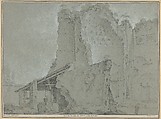Temple of the Sun and the Moon in Rome
Jean Barbault French
Not on view
Drawings by Barbault are exceedingly rare, only about ten have been published. These are the first two landscape drawings to come to light, although there must have been many, as hundreds of prints of Roman sites are described as after drawings by Barbault. Two drawings, depicting different sites, but with the same medium and dimensions as the proposed pair, were noted in the inventory of the marquis de Marigny, directeur des bâtiments du roi, who had visiting Rome in 1750. Aside from the inscriptions on the mounts, the attribution is also supported by the style, especially that of the figures, which are close to others in Barbault’s paintings. The choice of black and white chalk on blue paper for landscape drawings was popular among French pensionnaires in Rome around 1750.
The drawing depicts the Temple of Venus and Roma, an ancient Roman Temple built by Emperor Hadrian in 135 AD on the eastern edge of the Forum. In the eighteenth century, it was sometimes erroneously referred to as the Temple of the Sun and Moon, as in the inscription on the mount. The Temple was originally made up of two large hemi-circular chambers, oriented back to back and facing in opposite directions and each housing a statue of one of the eponymous goddesses. Visible in Barbault’s drawing is the west-facing ruined chamber of the goddess Roma. The rustic open air addition built on the side of the ancient temple to cover a well used by washerwomen was evidently not the artist’s whimsical invention, but an actual structure, for it appears, essentially unchanged, in drawings of the same spot by Hubert Robert (1733-1808) and Charles Louis Clérisseau (1722-1820).
The drawing was acquired together with a pendant (see 2014.459.2).
Perrin Stein, February 2018
This image cannot be enlarged, viewed at full screen, or downloaded.


